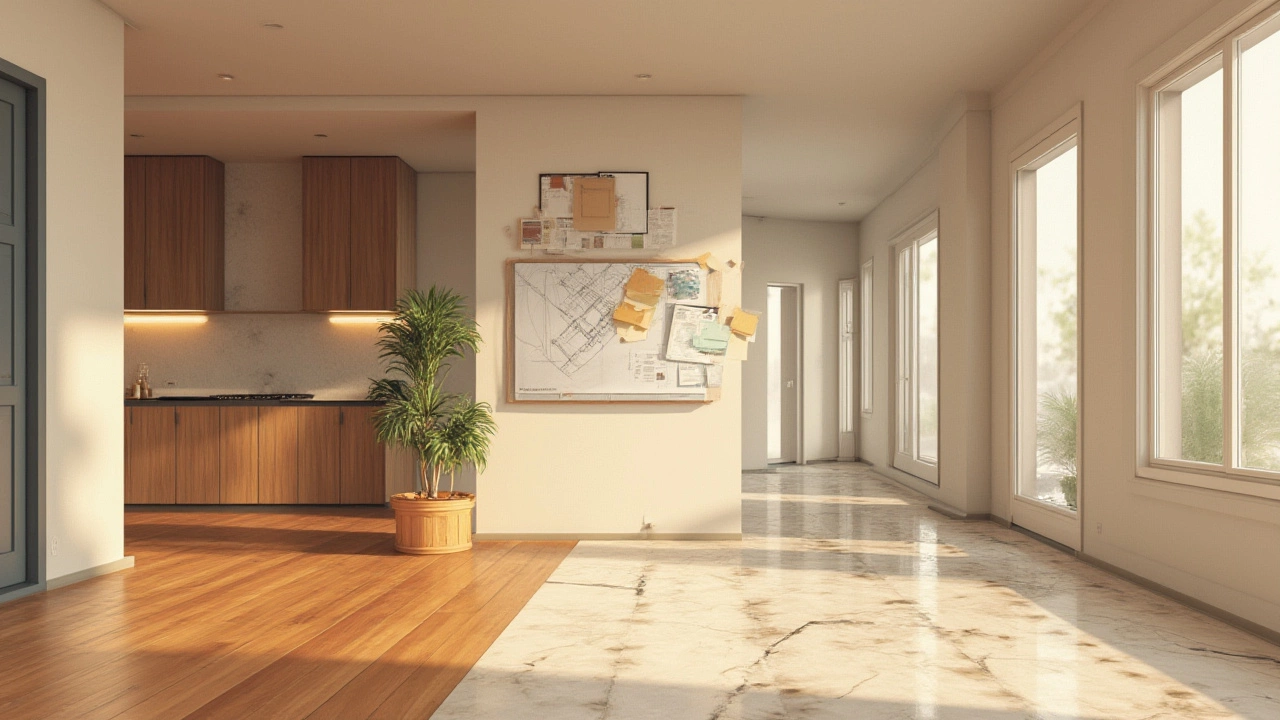Picture this: you finally get the call to do the walkthrough on your brand new home. You’re buzzing with excitement, keys in hand, and fresh paint scent in the air. You swing open that door… and stare at a sea of rough, cold concrete. Wait—where’s the fancy tile, that plush carpet, or the shiny hardwood you imagined strutting across? Here’s the question so many forget to ask: do you actually get flooring in a new build, or is that dreamy floor just something you saw in a glossy brochure?
Why Some New Builds Don’t Include Flooring
If you haven’t built a house before, you might assume a new build comes fully finished, including the floors. But, depending on where you are and which builder you choose, that’s not always the case. The classic move by many homebuilders—especially in the UK, Australia, and certain parts of the US—is to leave the flooring out entirely. Instead, you’re handed a blank slate, usually that raw concrete or plywood subfloor. Why does this happen?
Cost is the main driver. Builders sometimes offer flooring as an “optional extra” so they can advertise a lower base price and keep up with tough competition. This move cuts upfront costs, and for some buyers, skipping factory-installed flooring means having the freedom to pick something special that fits their lifestyle. Maybe you want eco-friendly bamboo, bold tiles, or hard-wearing vinyl because of pets or kids. Builders also like to avoid complaints about design choices by leaving it to you. For custom home builds, it’s pretty common that flooring is not included unless you negotiate it in.
Sometimes, the decision comes down to what’s selling locally. In certain neighborhoods, unfinished homes quickly find buyers—because people want to personalize every inch. In others, buyers expect that finished, move-in-ready feel. If you’re shopping for a new build, never assume flooring is standard—double-check your purchase contract, or you might end up surprised (and cold-footed) when move-in day rolls around.
What Types of Flooring Are Usually Offered in New Builds?
So what do you actually get if the builder does include flooring? That depends on the company and the price range. Some builders include basic options as standard—usually carpet in bedrooms, laminate or sheet vinyl in living spaces, and simple tile in bathrooms. Higher-end developments might offer engineered hardwood, luxury tile, or plush, top-shelf carpets as part of the deal. But “standard” rarely means premium, and upgrades are almost always offered for an extra fee.
Here’s where things get interesting. Some builders have swanky “design centers” where buyers can tour hundreds of samples—wood grains, tile patterns, luxe carpets—to create the exact look they want. It’s not just about color—a lot depends on how the materials handle moisture (think kitchens and bathrooms), stand up to pets, or feel underfoot. But watch your wallet: the average flooring upgrade package can tack on anywhere from $3,000 to $15,000, depending on how fancy you go. Some new build buyers get caught by surprise when they see how quickly the costs add up.
| Flooring Type | Estimated Cost per Sq Ft (2025) | Features |
|---|---|---|
| Carpet | $2 - $7 | Warm, good for bedrooms/kids |
| Laminate | $3 - $8 | Budget-friendly, tough, wood-look |
| Vinyl Plank | $4 - $10 | Water resistant, pets/kids friendly |
| Tile | $6 - $15 | Durable, cool, ideal for wet rooms |
| Hardwood | $7 - $20 | Classic, upmarket, value-adding |
Tip: If the builder bundles standard flooring, ask which rooms get which materials, and what counts as an ‘upgrade.’ Sometimes, only bedrooms or entryways get covered, with the rest left unfinished, unless you shell out for the full package.

The Hidden Costs of Builder Flooring Packages
Here’s something you won’t see on the sales banner: builder flooring packages often look simpler and cheaper than they are. The quote in your contract may just reflect the cheapest, lowest-quality materials available—imagine basic thin carpet with basic foam underlay, or shiny, slippery tiles that show every footprint. If you want more comfortable (or durable) options, every little upgrade is an extra charge.
It gets tricky: sometimes the builder’s “included” range is only available in dull colors, or has stains/patterns you’d never pick for yourself. Even things like trim, transitions, and special underlays can bring extra charges. Some contracts don’t include removal of debris, or require you to deal with leftover scraps. The cost isn’t just about materials, either—builder markups on labor can be steep. Some buyers who choose upgrades see their flooring bill balloon by 20-50% more than what a local flooring store would charge. Without shopping around, you might pay more for the builder’s convenience.
There’s also the time pressure. Builders usually need you to decide on your floor choices early in construction. If you miss the deadline, your options shrink, or you get default picks. For folks who change their minds easily, this can mean a hasty, pressured decision that sticks for years.
- Always get a full written breakdown of what’s included (rooms, materials, grades).
- Ask if you can decline builder flooring altogether, and finish it yourself after closing—some people save thousands this way.
- Compare samples side by side, not just in a catalog or showroom, to see how they look in real light.
- Confirm who is responsible for cleaning/touch-ups if you install your own flooring later.
Should You Let the Builder Do the Flooring—or Go DIY?
It’s tempting to let the builder handle everything—nice and easy. But sometimes, skipping the builder’s flooring package and getting it done yourself after you close on the house gives you better materials, more control, and better pricing.
If you go with a local flooring company after closing, you can shop at your own pace, bring in your own installer, see a bigger selection, and even negotiate package deals. Some buyers save up to 40% by going this route, especially on mid-range to premium floors. The downside: you’ll need to plan around an unfinished house for a week or two after move-in. No-mess zones are a must—little ones and pets can kick up a lot of dust until the work is done, so be ready for a brief bit of chaos. You also need to check your mortgage contract—sometimes, lenders want finished floors before approving the loan, which could force your hand.
But the builder has some advantages too. They can get your whole house floored on schedule, with all the demolition, debris removal, and warranty included (sometimes). This is best for buyers who hate project-managing, or who can’t get time off work for extra contractors. Just pay attention to the contract. If you go this route, take time to walk the site before flooring goes down, and clarify which defects or snags the builder will fix at their cost.
The magic word here is flooring new build. If you want hot tips: pay close attention to how the warranty works. Does the builder give you coverage for defective installation, and for how many years? Get this in writing—or you could get stuck fighting over it if issues pop up later.

FAQs and Tips for Navigating New Build Flooring Decisions
Still a bit lost? Here’s a quick-hit list of things every sharp buyer asks before making decisions on flooring for a new build.
- Do all new builds come with flooring? No—many developments only include basic flooring, while some don’t include any at all. Always check your specific contract.
- Can you customize your flooring with the builder? Usually, yes. But options (and prices) vary wildly based on builder relationships with flooring suppliers.
- Can you wait and do the flooring after you move in? If your mortgage and local codes allow, yes. This saves money and lets you shop the open market.
- Are builder-installed floors good quality? Sometimes, but often whatever comes standard is pretty basic—upgrades cost a premium. Get details in writing.
- How do upgrades work? The initial quote is for “standard.” Builders let you swap to nicer materials or colors at an extra cost, often using their own supplier. Always check the markup.
- Where do most people splurge on flooring? Kitchens, entries, and primary bedrooms or ensuites. These are high-traffic/social areas you’ll use every day.
- What if I have allergies or pets? Consider hard floors (vinyl, tile) in main living spaces, with washable rugs. Hardwood is classic but scratches easily.
- What about warranties? Builder warranties sometimes only cover installation problems, not wear/tear. Third-party installers may give one-year or longer warranties.
- Can I negotiate flooring costs with the builder? Yes—especially on upgrades or higher-cost homes. If you don’t ask, you don’t get!
When you’re deep in paperwork and builder meetings, it’s easy to overlook flooring choices. But whether you want finish-it-yourself freedom or a fully turnkey home, knowing what’s included—and reading the fine print—turns confusion into confidence. Happy house hunting, and don’t forget to ask what’s under your feet before you sign that dotted line!

Written by Fletcher Abernathy
View all posts by: Fletcher Abernathy